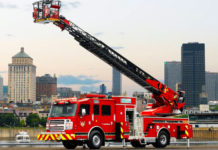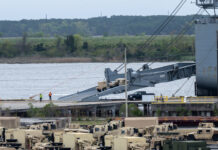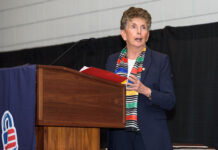Over the last 100 years, Honeywell and its legacy aerospace companies have made countless innovations in efficiency, reliability, passenger comfort and perhaps most important… flight safety.
Here are five standouts, showing how the aviation industry continually builds on previous accomplishments.
Prevent Flying into the Ground
In 1975, Honeywell engineers developed the first Ground Proximity Warning System (GPWS) to help with controlled flight into terrain.
Honeywell’s subsequent Enhanced GPWS (EGPWS), introduced in 1996, combined a worldwide digital terrain database and global positioning system technology.
These innovations have been credited with saving thousands of lives.
(Honeywell manufactures many types of Enhanced Ground Proximity Warning Systems, shown here. These constantly monitor terrain and obstacles near an aircraft and warn pilots if either get too close. Courtesy of Honeywell Aviation and YouTube)
Avoid Midair Collisions
As devastating as an aircraft crashing into a mountain may be, one of the worst aviation fears is that of two planes colliding in midair.
The Traffic Alert and Collision Avoidance System (TCAS) was designed to prevent these collisions by monitoring the airspace around an aircraft and warning pilots of the presence of other transponder-equipped aircraft.
Since this all takes place independent of air traffic control, the system works anywhere over land or sea.
In 1990 Honeywell’s Bendix/King became the first company to receive FAA manufacturing authorization.
(Honeywell offers SmartTraffic® Traffic Collision Avoidance System (TCAS) for most business aviation, air transport and regional aircraft. Courtesy of Honeywell Aviation and YouTube)
Manage Weather Conditions
Adverse weather poses a direct and real threat to aircraft, costing the aerospace industry billions of dollars each year through delays, cancellations, diversions, disasters, turbulence and severe storm activity.
While developments in weather radar systems have been steady since World War II, Honeywell made a significant advance when it introduced IntuVue™ 3D weather radars in 2008.
(Honeywell’s weather RADAR systems use the latest in digital signal processing to detect incoming windshear, turbulence and heavy weather, allowing pilots to adjust potentially hazardous flight paths in plenty of time. Courtesy of Honeywell Aviation and YouTube)
The IntuVue RDR-400 continuously and automatically scans all the weather in front of the aircraft, storing data in a 3D buffer, thus creating a three-dimensional image of the weather and terrain, reducing pilot workload and increasing situational awareness for maximum safety.
(Learn More. Pegasus Airlines and its passengers see the benefits of IntuVue™ RDR-4000. Courtesy of Honeywell Aviation and YouTube)
Coordinate Airplane Arrivals and Takeoffs
It’s important that an aircraft’s movements coordinate with the hundreds of other aircraft utilizing the airport.
Honeywell’s SmartPath Ground-Based Augmentation System (GBAS) reduces flight delays for passengers while helping airline operators reduce fuel costs and traffic congestion by transmitting digital data to the aircraft.
Unlike traditional instrument landing systems, Honeywell’s GBAS is immune to interference from weather, other aircraft and rugged terrain.
(Honeywell’s flight engineers and test pilots provide an overview of Ground Based Augmentation Systems, and explain the operational benefits to operators and pilots of using satellite navigation for precision approach and landing. Courtesy of Honeywell Aviation and YouTube)
(Honeywell’s SmartPath ground-based augmentation system, or GBAS, is a precision landing solution for airports that increases capacity and reduces delay, air traffic noise and operating costs for aircraft operators and air navigation service providers. Courtesy of Honeywell Aviation and YouTube)
Protect Runways
SmartLanding™ and SmartRunway™ build on existing Honeywell EGPWS technology to address runway incursions (unauthorized aircraft or vehicle on a runway) and excursions (aircraft departing a runway inappropriately during take-off or landing) — an almost daily occurrence.
SmartLanding alerts the crew if the aircraft is unstable on approach or is landing too far down the runway to stop—a cost-effective way to reduce risk at crowded airports. SmartRunway alerts pilots about runway and taxi locations.
(A next-gen software option for Enhanced Ground Proximity Warning Systems, Honeywell’s SmartRunway and SmartLanding systems are designed to minimize runway incursions and excursions, improving the situational awareness of pilots and crew by means of audio alerts and visual messaging during taxi, takeoff, approach and landing. Courtesy of Honeywell Aviation and YouTube)
Original post https://www.honeywell.com/newsroom/news/2017/01/five-technologies-that-make-flying-safer

















